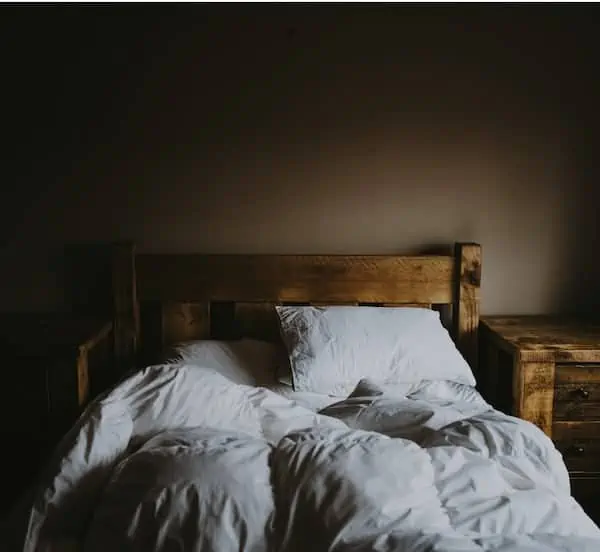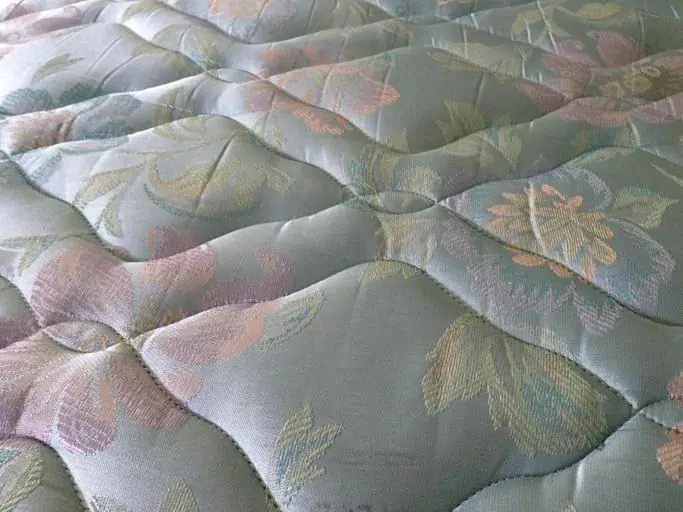Are you seeing early bed bug stains on sheets? If so, you may be concerned about bed bugs. Bed bugs are a pest that can wreak havoc on your home. If you suspect that you have bed bugs, it’s important to take action as soon as possible.
Unfortunately, getting rid of bed bugs can be tricky, especially if an infestation is out of control. The good news is that there are some early warning signs you can keep an eye out for to help you determine if you are dealing with bed bugs.
So, along with early bed bug stains on sheets, we’re going to talk about some of the early warning signs of bed bugs.
Contents
But Before We Begin, What Are Bed Bugs?
Bed bugs are small arachnids related to ticks and spiders.
Bed bugs are small, brownish, flat insects that feed on the blood of animals and humans. They are about the size of an apple seed and can be found in the seams of mattresses or box springs, behind baseboards, in cracks and crevices, and even inside electrical outlets.
Bed bugs do not fly, but they can move quickly over floors, walls, and ceilings. Their flattened bodies allow them to fit into tiny spaces. Bed bugs have been known to hide in electronics such as wall clocks or radios. They crawl out at night to feed on humans. A female bed bug lays multiple eggs each day and may lay 500 over her lifetime, meaning that a single pregnant female bed bug can lead to an entire bed bug infestation and early bed bug stains on sheets.
Bed bugs have six life stages: egg, nymph, subadult, adult, and gravid and/or mated female. The eggs are tiny and whitish in color. They are laid in batches of 10-20 eggs on rough surfaces such as wood or cardboard. Each female can lay up to 500 eggs over a lifetime.
The nymphs are approximately one mm long when they hatch from the eggs, and they grow to about five mm after molting five times. After the fifth instar, they molt into subadults. Bed bugs go through five nymphal stages before becoming adults.
The subadults are reddish-brown in color and are about 7-10 mm long when fully grown. While they do not feed on humans, they will feed off of other animals for nourishment if necessary.
Adult bed bugs are oval-shaped and brownish-red in color with an approximate length of 5-7 millimeters (1/4 inch). They have been known to live up to one year without feeding on blood or other hosts; however, once mature adults have fed on blood once they can survive up to six months without feeding again! This means that even if you get rid of your bed bug infestation initially, you can have other bed bugs hiding out in wait for up to six months before attacking again.
Bed bugs aren’t like mosquitoes, fleas, or lice; they’re classified as arachnids like spiders because they have eight legs rather than six legs like insects have. Bed bugs get their name because they prefer to hide in beds and other places where people sleep — such as mattresses, box springs, and bed frames — but they can also be found in many other areas of a home or apartment.
These pests are most active at night and are attracted to the warmth and carbon dioxide exhaled from a sleeping person’s breath. They feed on blood, usually at night while you’re sleeping, but sometimes during the daytime if hungry enough. Bed bugs don’t transmit disease, but their bites can cause itchy welts on your skin that may become infected if scratched. (More on this further down).
Bed bugs were once thought to be eradicated in developed countries because of insecticides used in the 1940s through 1960s, but they’re making a comeback in recent years. This is because of increased resistance among populations, travel, and international commerce and trade.
Are Bed Bugs Dangerous?
Though bed bugs are not dangerous, their bites can be painful and itchy for those with sensitivities.
Although bed bugs can cause quite a bit of stress and anxiety, they are not physically dangerous to people or pets. With that said, their bites can cause itching and some minor skin irritation to those with sensitivities. For the most part, though, the majority of people will develop no symptoms after being bitten by a bed bug.
Still, some people may have an allergic reaction to bed bug bites that can cause hives or swelling that lasts for several days to weeks. In rare cases, anaphylaxis (a severe allergic reaction) may occur after a person is bitten by a bed bug. Again, this is very rare.
While bed bugs are nasty, you can be reassured that they do not spread disease to humans. Furthermore, their bites are generally painless due to properties in their saliva that numbs the skin before they bite.
Bed bugs also do not live on human blood alone, though they do prefer human beings to animals. But if humans are not readily available, bed bugs will also feed off of kennel animals such as dogs, cats, and other mammals that live inside homes with humans.
Due to their unique ability to live without a blood meal for over six months and due to their ability to procreate so rapidly, bed bugs can be quite difficult to get rid of.
They are challenging to detect early on because they hide during the day when we’re awake so we don’t see them, unlike other pests like cockroaches or ants that are usually seen more often during the daytime hours when we’re awake enough to notice them crawling around our homes.
Once you do catch a living bed bug in action, it’s usually an indication that an infestation has already gotten out of control.
So, how do you know if you’re dealing with bed bugs before they get out of control? Experts say there are 10 early warning signs including early bed bug stains on sheets that you should look out for, and we’ve listed them below.
1. Waking Up With Strange, Unexplained Bites
Bed bug bites appear in clusters.
Waking up with strange, unexplained bites is a red flag that you might have bed bugs.
Bed bug bites are not always easy to see, but they’re usually very distinctive. You may spot them on your arms and legs, possibly on your face and neck too. They’ll often be grouped together in a line or cluster.
The bites themselves can look like small red dots or bumps. Sometimes they’ll appear in clusters of two or three — much like mosquito bites — while in other cases they appear as small red dots surrounded by slightly swollen skin (red wheels). A bed bug bite may also be more itchy than painful, though some people experience both sensations when they’re bitten by these pests.
If you wake up with strange marks on your body that don’t seem to match any insect bite you’ve ever had before, it’s possible that you’ve been bitten by bed bugs — especially if you live in an area that’s known for having them. If this happens to you, try looking for other signs of infestation around your home too like early bed bug stains on sheets.
2. A Musty Scent You Can’t Quite Place
A strong odor that is sickly sweet is commonly a sign of bed bugs.
If you’re a homeowner, you might be familiar with the musty smell that comes from a damp basement or moldy bathroom. But what about when you can’t quite place that musty scent? Along with early bed bug stains on sheets, this musty smell could be a sign of bed bugs.
Bed bug infestations typically start with one or two bugs and then slowly increase in number over time. As they grow in numbers, they also spread to new areas of your home. The main way they do this is through their bodies, and the smell can carry their scent far beyond where they are located.
The bed bug pheromone is a strong, sweet-smelling liquid that they excrete out of their bodies when they are scared or agitated. This liquid has an effect on humans and animals alike, causing them to feel dizzy and disoriented. It can also cause some people to become nauseous from the smell. This is why many people describe a musty odor as something that smells like death or rotting flesh because it mimics those two odors closely.
If you have detected a musty scent in your home, it may be time to call an exterminator to ensure that there aren’t any bed bugs lurking around your property.
3. Small Blood Stains On Your Sheets
Blood stains on your sheets are often an early warning sign of bed bugs.
Are you noticing early bed bug stains on sheets? It is true that early bed bug stains on sheets can be a sign of bed bugs, but what exactly are these stains?
Blood stains on your sheets is one of the most common signs of bed bug infestation in the United States and other parts of the world.
But why are early bed bug stains on sheets a sign of bed bugs?
Bed bugs suck blood from humans or animals while they sleep at night. The red-colored liquid that we see on our sheets after waking up is actually our own blood! These tiny parasites are quite capable of causing not only skin irritations and rashes, but they can also cause psychological issues like anxiety due to fear of being bitten by these small creatures again and again.
Early signs of bed bug stains on sheets will not help ease this anxiety. The blood can permanently stain your sheets and be a constant reminder that you or your loved ones are being bitten by something after you close your eyes.
4. Noticing Black Marks On your Sheets Or Mattress That Look Like Ink Blots
If you notice ink-blot like stains on your bed, you could be looking at bed bug feces.
If you think you have bed bugs, the first thing to do is take a look at your sheets. Black marks on your sheets or mattress that look like ink blots are a sure sign of bed bugs and count as early bed bug stains on sheets.
If you find these marks on your sheets, it’s important to act quickly. The sooner you treat them, the better. If you don’t treat them quickly enough, they can multiply and spread to other areas of your home very quickly, as we’ve now learned.
But what are these black marks on your sheets? These black spots are early bed bug stains on sheets, and they are not blood. In fact, they are actually the fecal matter left behind by these pests.
You can find these black spots on sheets, along mattress seams, along furniture legs, and even on your headboard, pillowcases, or bedding.
5. Insect Shells Along Your Mattress Seams
Bed bugs often shed and leafe their shells along seams of your mattress.
Insect shells along your mattress seams is another common sign that you have a bed bug infestation. These tiny bugs shed their skins as they grow, leaving behind their old exoskeletons. If you see these shells along the seams of your mattress, it means that there are live bed bugs in your home. It’s important to do thorough investigation if you notice shed skins. Use a flashlight and look closely in areas you have found shed skins, as you may find eggs of these insects here as well.
A good way to tell if there are any live bed bugs in your home is by looking for insect shells around the seams of mattresses and pillows. If you find any, it means that there is an infestation going on in your home and you should contact a pest control expert immediately or be quick to use products that are designed to get rid of bed bugs as quickly as possible.
6. Finding Signs Of Bed Bug Eggs
Bed bug eggs are commonly found in seams of beds.
Another sign of bed bugs, along with early bed bug stains on sheets, are going to be bed bug eggs that are small and white, oval shaped. They are about 1 mm in length and do not have any coloration or markings. Bed bug eggs are very easy to spot and can be found on the surface of the mattress, the box spring, and around the edges of the room. It is important to get rid of these eggs as soon as possible because they will hatch after about 10 days.
The first time that you see any signs of bed bugs in your home, it is important to contact a professional pest control company immediately. The longer that you wait to treat bed bugs, the more likely it is that you will have an infestation on your hands, as we’ve mentioned.
7. You’ve Recently Traveled
Travel could put you at higher risk for dealing with bed bugs when you get home.
If you’ve noticed any of the above early signs of bed bugs or early bed bug stains on sheets, you may have bed bugs. But there are also a few factors that could make you even more likely to have bed bugs.
For example, if you’ve recently traveled, you may be at even more risk of bringing bed bugs home with you.
Bed bugs can travel in your luggage, clothing and other belongings. If they are already present in your home, they can easily move between rooms and even apartments or houses.
If you’ve recently stayed in an infested hotel room or slept in an infested bed, there’s a good chance you brought some bed bugs home with you.
8. Your Neighbors Or Friends Have Bed Bugs
If your neighbors have bed bugs and you live close by, it could be more likely that you have bed bugs.
If you’re not sure whether you have bed bugs, but you suspect you might, check with your neighbors. If the people who live in the apartment next to yours have bed bugs, there’s a good chance that your apartment has them too.
Bedbugs are very difficult to eradicate. They can spread from one apartment to another through shared walls and other cracks in the building. If your neighbors have been able to get rid of them, they may be able to help you do the same thing.
Another reason why you might have bed bugs if your neighbors do is because they could be bringing them into your building on their clothes and luggage after returning from travel abroad. Bedbugs don’t respect borders, so if your neighbor has been traveling recently and hasn’t taken precautions against infestation, he or she may have brought some home and shared them with you.
9. You’ve Recently Purchased Used Furniture
Buying clothing or furniture from a second hand store without inspecting it carefully could lead to you bringing home bed bugs.
Have you recently bought used furniture?
This is a very common way for people to get bed bugs. The reason for this is because many people don’t realize they have bed bugs when getting rid of furniture.
Bed bugs are not just found in hotels, motels, and other places where people sleep. They can also be found in second-hand furniture stores, thrift shops and flea markets. If you have recently purchased used furniture, it’s possible that you have brought bed bugs home with you.
All types of furniture can serve as a common hiding place for bed bugs. They like to hide in cracks and crevices, such as the seams of upholstered furniture. The most common types of furniture you should avoid when looking at second hand furniture includes:
Mattresses: This is one of the most common places for bed bugs to live. They can infest any part of the mattress, from the box spring to the mattress itself. You may also find them hiding on or under the sheets or blankets.
Couch Covers: You may not realize that your couch has been infested with bed bugs until you start seeing signs of infestation. You can check for signs by lifting up the cushions and looking for black spots or fecal matter on the fabric underneath them. If you see these signs, call a pest control professional immediately!
Other Furniture: Bed bugs really can live anywhere in your home where there’s enough room for them to hide out and multiply unnoticed. Be cautious of:
- Mattresses
- Box Springs
- Beds
- Bed Frames
- Headboards
- Nightstands
- Dressers
- And Chests of Drawers
10. Seeing Bed Bugs Themselves
Seeing bed bugs themselves is a sure sign you have the pests.
Seeing bed bugs themselves is no longer a warning sign of bed bugs – it’s a red alert of a bed bug infestation. The first time you notice a bed bug on your skin, you may not realize what it is. Remember, bed bugs are small (about 1/4 inch long), so they can be hard to spot. They’re also nocturnal, which means they don’t come out during the day when there’s light and activity around.
You may also see bed bugs crawling around during the day, especially if there hasn’t been much activity in your home for several hours or if your infestation is severe. But typically, you’ll see them at night if you wake up at odd hours or when making your bed.
It’s important to remember that even if you only see one bed bug, it doesn’t mean that the infestation is minor. Often by the time you physically see bed bugs, it means that an infestation has taken place and it is time to take the next steps to getting rid of them quickly.
Seeing Early Bed Bug Stains On Sheets? Here Are Products We Recommend For Getting Rid Of Bed Bugs
Diatomaceous earth can help get rid of bed bugs. It is also safe for use around children and pets.
Bed bugs are notoriously difficult to remove. They can hide in the smallest of places, and they’re good at staying out of sight until you’re asleep. If you do notice early bed bug stains on sheets, there’s no need to panic: Bed bugs are a nuisance, but they are not dangerous. They don’t transmit disease, and unless you have a severe allergic reaction, their bites are barely noticeable.
Still, it’s important to choose the right products for bed bug removal because these pests can be tricky to treat. There are two main types of products when it comes to bed bug removal — sprays that kill the adult bugs on contact and foggers that kill them in one shot — but there are also some do-it-yourself options that work well on bed bug infestations. Below are three products we recommend for getting rid of bed bugs yourself.
Harris Bed Bug Killer Liquid Spray
No products found.
Harris Bed Bug Killer Liquid Spray can be used by professionals or by homeowners who want to treat their own homes for unwanted pests like bed bugs, especially if you have noticed early bed bug stains on sheets.
Harris Bed Bug Killer Liquid Spray is an effective bed bug killer that works fast to effectively kill bed bugs. It is a non-toxic, non-staining and odorless spray that can be used on any surface. This product can be used in homes, hotels, hospitals and even schools.
The product kills bed bugs on contact. It also prevents them from coming back by leaving a residual effect that lasts for up to six months after application. The product works by breaking down the exoskeleton of insects and suffocating them to death.
You can use this product on fabric or upholstery such as mattresses, box springs, sofas, chairs, carpets and other furniture items that are infested with bed bugs. You can also use it outdoors on lawn furniture such as picnic tables and benches as well as other areas in your garden where these pests may hide out during the day time hours when they are not feeding on you.
Hot Shot Bed Bug Fogger
No products found.
Hot Shot Bed Bug Fogger is a product that has been on the market for over 60 years and has been used by professionals and homeowners alike. The product is easy to use, safe for people and pets, and effective against bed bugs.
Hot Shot Bed Bug Fogger is an aerosol spray that kills bed bugs on contact. The main ingredient is pyrethrin, which is an insecticide derived from chrysanthemums. This chemical kills adult bed bugs within minutes of contact, but it won’t kill eggs or nymphs that hatch after application, so keep this in mind if you’ve noticed eggs or other early bed bug stains on sheets.
Pyrethrin belongs to a group of chemicals known as pyrethroids. Pyrethroids are derived from natural sources, such as chrysanthemums, but they have been modified so they’re more potent than their natural counterparts and less likely to be harmful to humans or pets who come into contact with them.
Diatomaceous Earth Crawling Insect Killer
No products found.
Diatomaceous Earth Crawling Insect Killer is a natural insect killer that can be used on a variety of pests like fleas, ticks, ants, earwigs, and of course bed bugs. It’s safe around children and pets, but should not be handled without proper safety precautions.
The product is made from the fossilized remains of diatoms, which are hard-shelled algae that were once abundant in our oceans. The fossils have been pulverized into a fine powder that can kill insects when it touches their exoskeleton.
The sharp edges of these particles puncture the exoskeleton of insects when they come in contact with it and cause them to die. This product is a natural way to get rid of these pests, however it must be reapplied if it gets wet.
How To Get Rid Of Bed Bugs Once You See early Bed Bug Stains On Sheets
Bed bugs can cause a lot of anxiety, but you can work to get rid of them once you discover you have them.
Bed bugs are a common problem in the United States. They spread easily and often live undetected for months or even years, feeding off of you at night when you’re sleeping. Bed bugs are a serious problem for landlords and tenants alike, because they can damage property value and cause quite a bit of stress and anxiety.
The best way to get rid of a severe bed bug infestation once you discover them or once you notice early bed bug stains on sheets is by using professional bed bug extermination services. However, if your bed bug problem is not as severe or if you would prefer to use your own methods for pest control, you can follow these below tips:
- Clean everything from top to bottom
- Vacuum every surface
- Wash all your clothes and linens in hot water (120 degrees F)
- Freeze clothing and linens for at least 48 hours before washing them
- Use quality products designed specifically for bed bug removal
Again, if you continue to notice early bed bug stains on sheets or other signs of a bed bug infestation even after following the above remedies for bed bug removal, it is time to call a trusted pest control company for help.
Best of luck and thanks for reading!


Jack founded our blog after two decades of working in the pest control industry. His vast experience dealing with a wide array of pests allows him to diagnose issues quickly and get to the heart of pest problems quickly and effectively. He has serviced more than 2,000 homes over his career and there is hardly any pest situation that he has not seen before.














